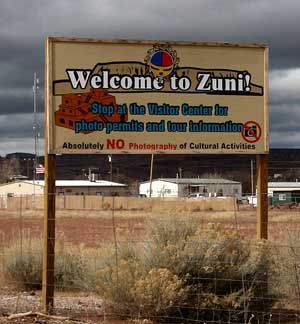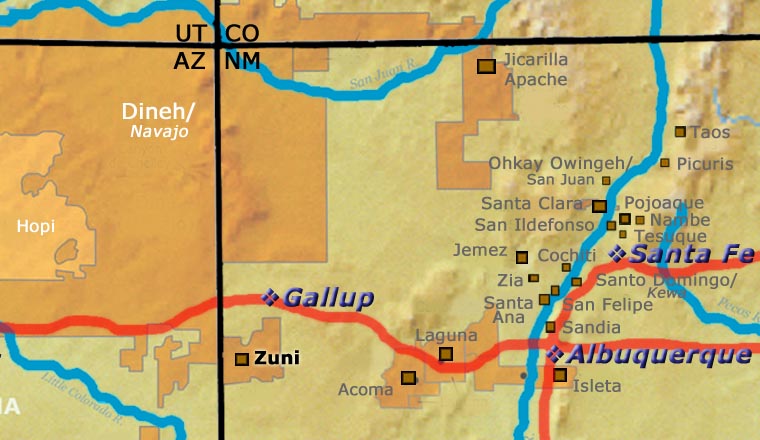
Zuni Pueblo

Welcome sign at Zuni Pueblo
Archaeologists have dated some sites on the Zuni Reservation back to the Paleo-Indian Period, more than 4,500 years ago. During the Archaic Period (2,500 BC to 0 AD), the forebears of the Zuni were hunter-gatherers and just beginning to develop agriculture. The Basketmaker Period (0 AD to 700 AD) saw agriculture become more developed and the Zunis were making their first pottery. The Pueblo I Period (700 AD to 1100 AD) saw an expansion of the population and larger settlements were built in the Zuni River area along with the development of the first painted Zuni pottery.
The Pueblo III Period (from 1100 to 1300 AD) saw further population growth in the Zuni River area and a shift from small houses to larger, plaza-oriented villages. The Pueblo IV Period (1300 to 1500 AD) was the time of the great drought and migrations as many tribal groups abandoned the Four Corners area and moved to locations near the Rio Grande, Rio Puerco, Zuni River and Little Colorado River. The main Zuni Pueblo was founded during this time but there were several other large villages in the area, too.
In 1540 there was a major battle fought between the Zunis and the forces of Francisco Vasquez de Coronado. Coronado first approached the pueblo at the end of a four-day religious festival. The Zunis had spilled a line of corn meal across the ground before the entrance to the pueblo, meant to signify to the Spanish that they shouldn't cross the line yet. Coronado interpreted that line of corn meal as an act of war and immediately ordered his soldiers to attack.
Coronado was almost killed in the fighting but his soldiers did finally win the battle. As Coronado and his men brought horses and sheep with them, they were probably the first such livestock the Zunis had ever seen. The gold the Spaniards were looking for: it turned out to be Sikyatki Polychrome bowls and jars, yellow clay gifts from the Hopis to the Zunis.
The Zunis did equip Coronado with a guide from the eastern Plains, someone who'd somehow made his way as a lone traveler to Hawikku. That refugee was supposed to be a guide for Coronado and his men but he was instructed by the Zunis to take Coronado into the Plains and get him lost there. When Coronado finally realized that, more than a year later, he ordered the guide executed, then turned his men around and headed back to Zuni and Mexico.
When he passed by Zuni in 1542, he left three Mexican Indians behind with the tribe. They most likely informed the tribal leaders of the extent of the Spanish domain in Mexico and the power they exercised there.
Except for a couple passing exploratory expeditions, they were left alone until the 1620s. Then came the friars who oversaw the construction of a mission church at Hawikku in 1629. At first the Zunis were friendly with the priests but with the forced labor requirements and forced religious conversions, the priests wore that welcome out quickly. Relations had changed drastically for the worse by the time of the Pueblo Revolt of 1680. The Zunis killed the priests and burned the missions but they preserved the relics and icons the priests had brought from Spain.
The tribe built a village near their fortress at Dowa Yalanne and prepared to defend their people and way of life against the Spanish army. When Don Diego de Vargas arrived with troops in 1692, he attacked the fortress twice and failed. Then he negotiated with the Zuni war chief and was allowed to ascend to the top of Dowa Yalanne. He found many relics from the destroyed missions there. With that knowledge, he arranged a peace between the Spanish and the tribe. Between 1693 and 1700 the tribe consolidated all their small villages into what is now the Pueblo of Zuni.
The railroads arrived in New Mexico in the 1880s and right behind them came the first Anglo traders. Over the next 50 years Zuni pottery turned more and more to what the traders wanted. With the push into mass production, the quality fell off. The end result was the value of Zuni pottery fell way off and the potters tired of what they were doing. Pottery making dropped off in the 1940s until only ceremonial vessels were being made. Catalina Zunie was teaching pottery making at the Zuni Day School through this time period but the Zuni pottery revival didn't really begin until Daisy Hooee began teaching pottery making at Zuni High School in the 1960s and 1970s.
An accomplished Hopi-Tewa potter with an excellent pedigree, Daisy applied herself to learning about Zuni pottery and became a consummate Zuni potter. She retired from teaching at the high school in 1974. Jennie Laate, an Acoma woman who married into Zuni and learned the Zuni way from Daisy Hooee, took over teaching the classes. Many of today's well known Zuni potters thank Jennie Laate for her teaching and inspiration. She taught until 1990 when she turned the classes over to her student, Noreen Simplicio. Noreen taught the classes for 2 years, then Gabriel Paloma took over.
Josephine Nahohai brought traditional Zuni pottery designs back into the community in the 1980s. Les Namingha has also recently been using more traditional Zuni shapes and designs in his Zuni revival pottery. Today, because so many Zuni potters learned their craft at Zuni High School, they mostly also use electric kilns for firing their works. Other than that, they all use the same traditional methods of gathering and processing the clay, making their pottery and painting their designs, traditional processes that are practiced in virtually the same way in all the pueblos.
100 West San Francisco Street, Santa Fe, New Mexico 87501
(505) 986-1234 - www.andreafisherpottery.com - All Rights Reserved

Nampeyo of Hano Family Tree
Disclaimer: This "family tree" is a best effort on our part to determine who the potters are in this family and arrange them in a generational order. The general information available is questionable so we have tried to show each of these diagrams to living members of each family to get their input and approval, too. This diagram is subject to change should we get better info.
-
Nampeyo of Hano (c. 1859-1942) & Lesou (c. 1860-1942)
- Annie Healing Nampeyo (1884-1968) & Will Healing
- Rachel Namingha Nampeyo (1903-1985) & Emerson Namingha (d. 1992)
- Priscilla Namingha Nampeyo (1924-2008) & Donnelly Sahmie (d. 2008)
- Jean Sahmie (1949- ) & Gordon Tom
- Donella Tom Zacharias (1972- )
- Kaniela Kootswatewa
- Donella Tom Zacharias (1972- )
- Randall Sahmie Nahto (1950-2008) & Alicia (1950- )
- Randall Sahmie Jr. & Lisa Willa
- Andrew Louis Sahmie (1952- ) & Ida Sahmie (Dineh)(1960- )
- Nyla Sahmie (1954- ) & Philip Collateta
- Kenneth Lynch (1974- )
- Tara Lynch
- Kira Lynch
- Michael Collateta (1981- )
- Christopher Collateta
- Seth Collateta
- Kenneth Lynch (1974- )
- Rachel Sahmie (1956-2022) & Ollie Talashie
- Carla Talashie
- Sean Michael Talashie
- Madison Moreno
- Carla Talashie
- Bonnie Chapella Sahmie Nampeyo (1958- ) & Ernest Chapella
- Doyle Sahmie
- Mickie Chapella
- Sahmie Chapella
- Jean Sahmie (1949- ) & Gordon Tom
- Ruth James Namingha (1926-2012)
- Darlene Vigil James (Nampeyo) (1956- ) & Felix Vigil (Jemez)
- Candice James
- Darlene Vigil James (Nampeyo) (1956- ) & Felix Vigil (Jemez)
- Eleanor Lucas (1926- )
- Karen Lucas
- Steve Lucas (1955- ) & Yvonne Analla Lucas (Laguna/Navajo, 1959- )
- Emerson Namingha
- Les Namingha (1967- ) & Jocelyn Quam Namingha (Zuni)
- Lillian Namingha
- Dextra Quotskuyva Nampeyo (1928-2019)
- Hisi Quotskuyva Nampeyo (1964- )
- Lowell Chereposy
- Erica Quotskuyva
- Reid Ami
- Dan Namingha (painter)
- Hisi Quotskuyva Nampeyo (1964- )
- Priscilla Namingha Nampeyo (1924-2008) & Donnelly Sahmie (d. 2008)
- Daisy Hooee Nampeyo (1906-1994)
- Louella Naha (1927- ) & Fred Enote Jr.
- Raymond Naha (1929-1975)
- Shirley Benn (1936- )
- Cheryl Naha (1961- )
- Marlin Pinto (1957- )
- Beatrice Naha Nampeyo (1912-1942) & Vinton Naha
- Regina Naha
- Terry Naha
- Regina Naha
- Dewey Healing (1905-1992) & Juanita Healing (1910-2006)
- Rachel Namingha Nampeyo (1903-1985) & Emerson Namingha (d. 1992)
- Nellie Nampeyo Douma (1896-1978) & Douglas Douma
- Marie Koopee (1917- )
- Jacob Koopee, Sr. (1940- ) & Georgia Dewakuku Koopee (1944- )
- Jacob Koopee Jr. (1970-2011)
- Jacob Koopee, Sr. (1940- ) & Georgia Dewakuku Koopee (1944- )
- Augusta Poocha Nampeyo (d. pre-1998)
- Zella Douma Ray [Kooyquaptewa][Nez]
- Marie Koopee (1917- )
- Fannie Polacca Nampeyo (1900-1987) & Vinton Polacca
- Elva Tewaguna Nampeyo (1926-1985)
- Miriam Tewaguna Nampeyo (1956- )
- Adelle Lalo Nampeyo (1959- ) & David Lalo
- Elton Tewaguna (1953- )
- Neva Polacca Choyou Nampeyo (1947- )
- Leah Garcia Nampeyo (1928-1974) & Lewis Garcia (1928-1974)(Laguna)
- Melda Nampeyo (1959- )
- James Garcia Nampeyo (1958-2019) & Fawn Navasie
- Rayvin Garcia Nampeyo (1961- ) & Jody (1/2 Zia)
- Harold Polacca Nampeyo (1930- ) & Alice Polacca
- Clinton Polacca (1958-2022)
- Vernida Polacca Nampeyo (1955- )
- Jeremy Adams (1988- ) & Mallorie Ovah
- Wiley Adams
- Jeremy Adams (1988- ) & Mallorie Ovah
- Reva Polacca Ami (1964- )
- Tonita Hamilton Nampeyo (1934- ) & Eugene Hamilton
- Loren Hamilton (1961- )
- Tom Polacca (1935-2003)
- Gary Polacca Nampeyo (1955- )
- Delmar Polacca
- Carla Claw (1961- )
- Elvira Naha (1968- ) & Marty Naha (1970- )
- Ellsworth Polacca Nampeyo (1940-1993)
- Iris Youvella Nampeyo (1944- ) & Wallace Youvella, Sr. (1947-2021)
- Doran Youvella (1982- )
- Nolan Youvella (1970-2020)
- Wallace Youvella Jr.
- Elva Tewaguna Nampeyo (1926-1985)
- William Lesou Komalestewa (1893-1935) & Vina Tahomana (d. 1918)
- Austin Komalestewa Sr. (1916-1987) & Emily Shupla (Hopi)
- Alton Komalestewa & Jeanne Shupla (Santa Clara) (d. 1989)
- Austin Komalestewa Sr. (1916-1987) & Emily Shupla (Hopi)
Some of the above info is drawn from Hopi-Tewa Pottery: 500 Artist Biographies, by Gregory Schaaf, © 1998, Center for Indigenous Arts & Studies. Other info is derived from personal contacts with family members plus interminable searches of the Internet and cross-examinations of the data found.
(505) 986-1234 - www.andreafisherpottery.com - All Rights Reserved
